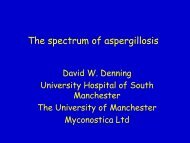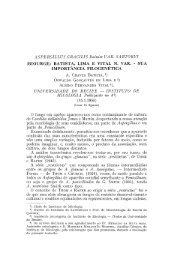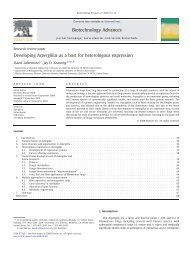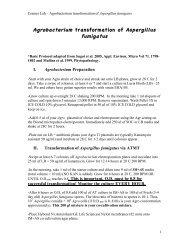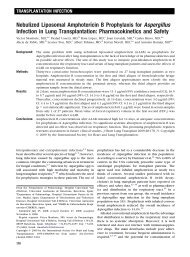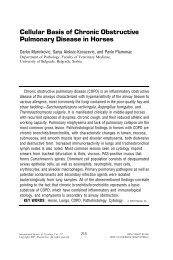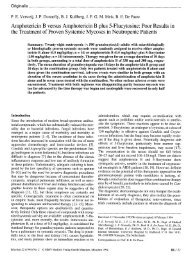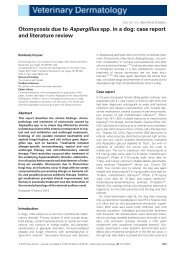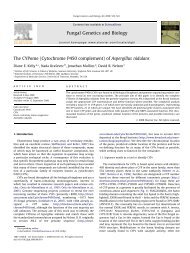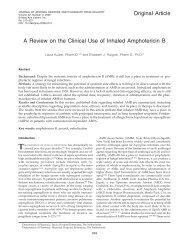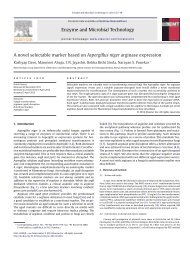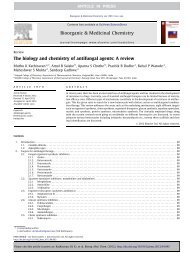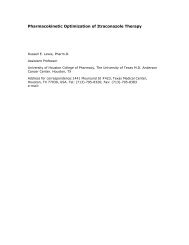Bioorganic & Medicinal Chemistry Letters
Bioorganic & Medicinal Chemistry Letters
Bioorganic & Medicinal Chemistry Letters
Create successful ePaper yourself
Turn your PDF publications into a flip-book with our unique Google optimized e-Paper software.
isoxazolidinone, these compounds also contain a xanthone ring<br />
system, closely related to the ergochrome subunit that dimerizes<br />
to form various secalonic acids. 6,7 Ring-opening of the xanthone<br />
by a retro-Michael reaction leads to the interconversion of 1 and<br />
2, along with epimerization of the quaternary carbon bearing the<br />
methyl carboxylate. Further, the chemistry of these natural products<br />
is complicated by the instability of the isoxazolidinone ring.<br />
Hydrolysis of the isoxazolidinone ring, which is accompanied by<br />
the elimination of a molecule of water, generates the inactive benzoquinoline<br />
analogs 3 and 4.<br />
Parnafungin A and B were initially discovered from two fungal<br />
strains that resembled F. larvarum Fuckel (Ascomycota, Hypocreales)<br />
and were isolated from lichens obtained from the province<br />
of Madrid, Spain. 1,5 Subsequent to the discovery of parnafungin A<br />
and B, additional fungal species resembling F. larvarum, which included<br />
strains isolated from plants, plant litter and lichens, were<br />
identified as parnafungin A and B producers. From this taxonomic<br />
study, 8 it was concluded that the F. larvarum complex could be resolved<br />
into at least six or, possibly, seven different species. However,<br />
the examination of additional related strains is necessary<br />
before definitive taxa can be described. After fermentation of these<br />
strains, an acetone extract of each sample was analyzed by reversed<br />
phase HPLC with diode array and mass spectrometric detection<br />
(HPLC-DAD-MS) in order to confirm the production of 1 and 2<br />
(MW 451). In all cases, the production of 1 and 2 were confirmed<br />
and, further, the CaFT profiles of these extracts matched that observed<br />
for purified parnafungins A and B.<br />
While probing the taxonomic relationship of these parnafungin<br />
producing strains, an acetone extract from strain F-155,597 was<br />
identified by HPLC-DAD-MS analysis as producing substantial<br />
quantities of two analogs along with lesser quantities of parnafungins<br />
A and B. 8 These new analogs shared similar absorbance spectra<br />
to that obtained for parnafungin A and B (kmax 350 nm), but<br />
differed in retention time and molecular weight (MW 465 and<br />
479). Additional metabolites having similar absorbance spectra to<br />
that of the inactive benzoquinoline analogs (kmax 450 nm) were<br />
also present in this sample with corresponding molecular weights<br />
(MW 465 and 479). Following the discovery of these additional<br />
parnafungins, single ion monitoring was able to confirm that several<br />
other strains from the F. larvarum complex also produced these<br />
compounds, but in less pronounced quantities than that obtained<br />
from strain F-155,597. Here, we describe the isolation, structure<br />
elucidation and comparative antifungal activities of the two additional<br />
parnafungins identified from strain F-155,597, designated<br />
here as parnafungin C (5) and parnafungin D (6).<br />
In order to determine the structure of parnafungin C and D, a<br />
large scale fermentation (1 L) of F-155,597 was prepared and extracted<br />
with one volume of EtOAc. After adsorbing this extract onto<br />
silica gel by removal of the solvent and then loading it on a silica<br />
cartridge, the column was eluted successively with 30%, 50%, and<br />
80% EtOAc in hexanes, followed by 30% methanol in EtOAc.<br />
HPLC-DAD-MS analysis (C18) indicated that the two new parnafungin<br />
analogs were present in the 50% and 80% EtOAc in hexane<br />
fractions, with the latter cut containing predominantly 5 and 6.<br />
The combined 80% EtOAc fractions were concentrated to dryness<br />
and further purified by preparative reversed phase C18 HPLC. This<br />
fractionation step provided purified components for full chemical<br />
characterization and structure elucidation. High resolution mass<br />
spec analysis of these samples was consistent with the molecular<br />
formulas of C24H19NO9 (466.1131, calcd for M+H 466.1138) and<br />
C24H17NO10 (480.0924, calcd for M+H 480.0931) for parnafungin<br />
C and parnafungin D, respectively.<br />
In our earlier work, 5 the structures of parnafungins A and B<br />
were determined after methylation of the mixture of those natural<br />
products with ethereal diazomethane, thereby stabilizing the components<br />
from interconverting. The mono-methylated products<br />
D. Overy et al. / Bioorg. Med. Chem. Lett. 19 (2009) 1224–1227 1225<br />
OH O<br />
8<br />
OCH3 12 11 7<br />
10<br />
O OCH 3<br />
A 15a<br />
15 O 6<br />
HO COOCH3 16 17<br />
N<br />
O 1<br />
4<br />
O O A<br />
O<br />
HO COOCH3 5<br />
6<br />
OH<br />
O OCH 3<br />
O<br />
HO COOCH3 7<br />
N<br />
OH<br />
O<br />
N O<br />
were purified and the structures of the methylated derivatives<br />
were resolved by NMR spectroscopy and X-ray crystallography.<br />
In that case, methylation occurred at the C12 position providing<br />
the corresponding methyl enol ethers. Methylation at the enol position<br />
prevented the retro-Michael opening of the A ring (Fig. 2),<br />
thereby blocking the equilibration between parnafungin A and parnafungin<br />
B as well as the epimerization at C15a.<br />
NMR spectroscopy was used to determine the structure of parnafungin<br />
C and parnafungin D. It was readily apparent from an<br />
analysis of the 1 H and 13 C 1D NMR spectra that there were two<br />
methyl groups present in parnafungin C as compared with only<br />
one in parnafungins A and B (Table 1). One methyl singlet (d<br />
3.57 ppm) corresponded to the methyl carboxylate at the quaternary<br />
chiral center (C15a). The additional methyl singlet resonance<br />
in paranfungin C (5) atd 3.86 ppm was distinct from that in the<br />
OH<br />
O OCH 3<br />
O<br />
HO COOCH3 Figure 2. Parnafungin C (5) and D (6) and the corresponding benzoquinoline<br />
analogs 7 and 8.<br />
Table 1<br />
1 H and 13 C NMR data for parnafungin C (5) a<br />
Position d C mult d H(J in Hz)<br />
1 167.3 qC<br />
4 54.9 CH2 4.73 (m)<br />
4a 140.3 qC<br />
5 110.3 CH 7.06 (s)<br />
6 160.7 qC<br />
6a 113.1 qC<br />
7 158.9 qC<br />
7a 115.6 qC<br />
7b 119.0 qC<br />
8 131.3 CH 8.33 (d, 8.0)<br />
9 126.3 CH 7.43 (t, 8.0)<br />
10 123.5 CH 7.75 (d, 8.0)<br />
10a 112.8 qC<br />
10b 156.2 qC<br />
11 184.8 qC<br />
11a 102.8 qC<br />
12 171.4 qC<br />
13 25.7 CH2 2.75 (m)<br />
2.54 (m)<br />
14 23.9 CH 2 2.14 (m)<br />
1.90 (m)<br />
15 70.2 CH 4.24 (d, 4.0)<br />
15a 85.6 qC<br />
16 169.8 qC<br />
17 52.7 CH3 3.57 (s)<br />
7-OCH3 61.9 CH3 3.86 (s)<br />
12-OH 5.9 (b)<br />
a 1 H spectra were accumulated at 500 MHz and 13 C spectra were accumulated at<br />
125 MHz in DMSO-d 6. Proton NMR spectra were referenced to the residual 1 H<br />
solvent peak for DMSO-d 5 at d 2.49. Carbon spectra were referenced to the DMSO-d 6<br />
septet at d 39.51.<br />
O<br />
OH<br />
8<br />
N<br />
OH<br />
O<br />
O



